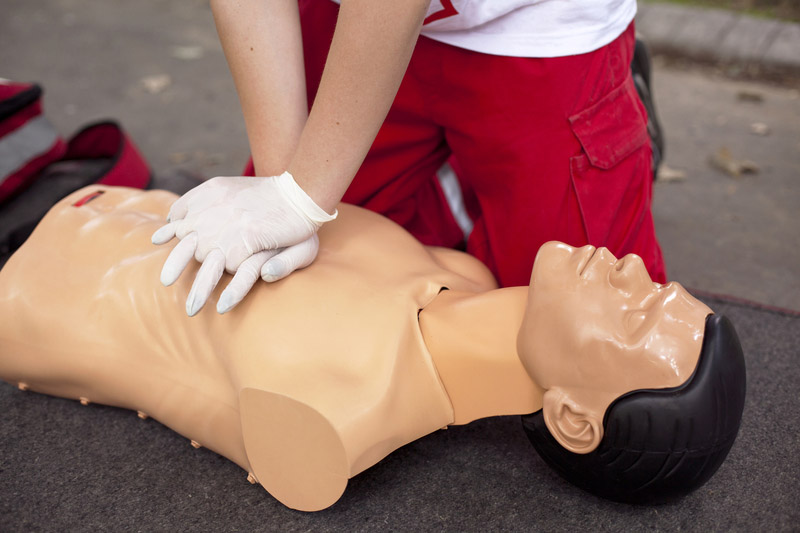We have been hearing from some of the people who have learned how to save a life by taking our FREE online CPR training. They have written in with questions regarding the safety of performing CPR during the pandemic.
They are not the only ones who have had questions. Researchers in Europe conducted a study to determine if aerosols, the airborne particles that can transmit the Covid-19 virus and other respiratory pathogens, were generated during the administration of cardiopulmonary resuscitation (CPR).
The researchers concluded that the chest compressions used when administering CPR did not cause significant aerosol generation. If you have taken a class in CPR, you probably know that chest compressions combined with mouth-to-mouth resuscitation is the most effective way to perform CPR, but these preliminary study findings are definitely good news.
It means that it might be possible to administer CPR safely even though the Covid-19 pandemic continues to take a toll on all of us. Please keep in mind, however, that this was a small, preliminary study. Further research will be needed to truly determine outcomes.
Is It Safe to Perform CPR in the Age of Covid-19?
Chances are you have spent a lot of your time at home over the past year. Most of us have. That means the chances of us being called on to use CPR have been limited. But now with the number of Americans who have been vaccinated steadily growing, the time has come to start thinking about getting out and about more.
If you find yourself in a situation that calls for CPR, the study conducted in Europe would recommend that you use the hands-only CPR method at this time. Hands-only CPR relies solely on chest compressions and does not require mouth-to-mouth contact.
Based on the European study, we can assume that CPR using only chest compressions would be considered a low-risk activity.
Does Using a Defibrillator Make a Difference?
If you have taken an online course in CPR, you were most likely trained in both conventional cardiopulmonary resuscitation (CPR) techniques and hands-only CPR. If you are certified in CPR or if you underwent online CPR training at your workplace, you were probably trained in the proper use of an automated external defibrillator, commonly referred to as an AED, too.
In addition to hands-only CPR, the researchers looked to see if they could detect aerosols during hands-only CPR that was being administered right before and right after a defibrillator had been used.
Hands-only CPR conducted before defibrillation also appears to be associated with very low-risk of Covid-19 transmission.
The research is not as clear when it comes to CPR used after defibrillation. Aerosols were detected in that situation, but the researchers said that their findings were inconclusive. They concluded that more research would be needed to determine the risks in that particular situation.
How Was the Research Conducted?
The study, which was presented as a Lighting Round Oral Abstract in the 2020 Resuscitation Science Symposium on November 14, 2020, was published in the December issue of the Resuscitation Journal, which is published by the European Resuscitation Council.
When it comes to the methodology used in the study, things get really interesting.
The researchers used what is called a “swine CA model.”
They wanted to simulate what would happen if someone went into cardiac arrest (CA) and someone who was trained in CPR was on hand to administer cardiopulmonary resuscitation. Obviously, they weren’t going to use a real heart patient or go out into the community, where there would be too many variables, to conduct their research. So, in a method that is commonly accepted in the medical research community, they used three female pigs.
They also compared the coughs of four healthy people to the aerosols generated by the swine.
What Precautions Should You Take When Performing CPR?
Your safety is always an important consideration when it comes to administering CPR. During the pandemic, we would like to recommend that you follow these safety guidelines.
- If you are performing CPR, limit yourself to chest compressions.
- Be sure to wear your face mask. Wearing a face mask is one of the most important tools you have at your disposal when it comes to protecting yourself and others from the spread of Covid-19.
- You will also want to be sure to wash your hands thoroughly or use hand sanitizer when you are done administering CPR.
- And be sure to get vaccinated!
If you have been staying at home over the past year, as so many of us have, you may want to brush up on your CPR skills so that, as you start to venture out more, you will be prepared to save a life if the situation arises.
We offer a FREE CPR Course as well as a FREE BLS Course that can serve as a refresher course. We offer both of our free CPR classes online so, if you have not been vaccinated yet or you just aren’t quite ready to get out and about yet, you can brush up on your CPR skills – including the method for using only chest-compressions – while staying safely at home.

